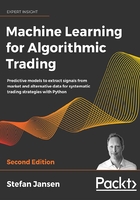
Summary
In this chapter, we introduced a range of alpha factors that have been used by professional investors to design and evaluate strategies for decades. We laid out how they work and illustrated some of the economic mechanisms believed to drive their performance. We did this because a solid understanding of how factors produce excess returns helps innovate new factors.
We also presented several tools that you can use to generate your own factors from various data sources and demonstrated how the Kalman filter and wavelets allow us to smoothen noisy data in the hope of retrieving a clearer signal.
Finally, we provided a glimpse of the Zipline library for the event-driven simulation of a trading algorithm, both offline and on the Quantopian online platform. You saw how to implement a simple mean reversion factor and how to combine multiple factors in a simple way to drive a basic strategy. We also looked at the Alphalens library, which permits the evaluation of the predictive performance and trading turnover of signals.
The portfolio construction process, in turn, takes a broader perspective and is aims at the optimal sizing of positions from a risk and return perspective. In the next chapter, Portfolio Optimization and Strategy Evaluation, we will turn to various strategies to balance risk and returns in a portfolio process. We will also look in more detail at the challenges of backtesting trading strategies on a limited set of historical data, as well as how to address these challenges.